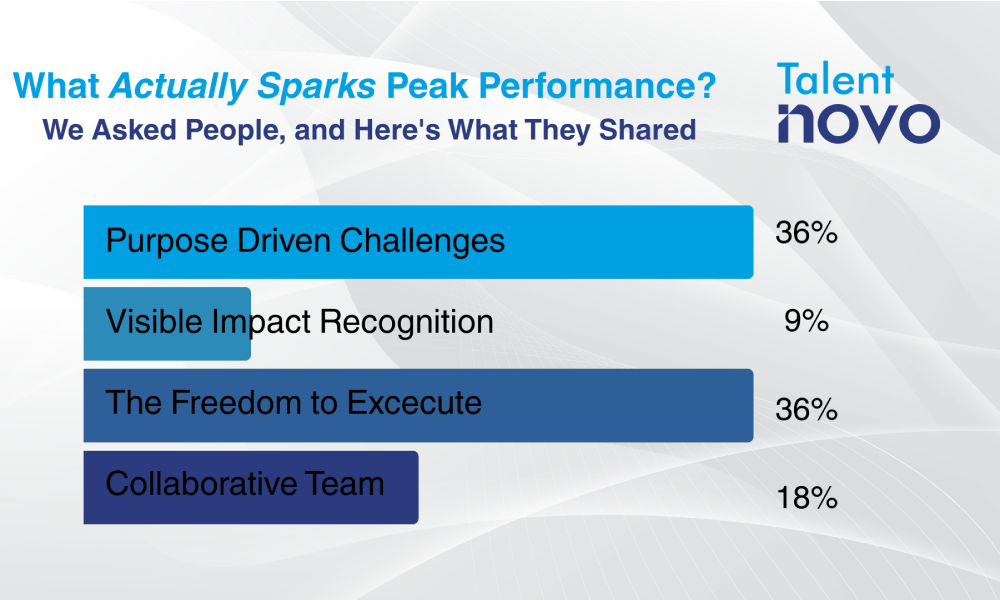Autonomy: The Hidden Engine of Peak Performance
Organizational culture significantly influences performance, and recent polling data reveals fascinating insights about what truly drives people to excel. With 36% of respondents identifying “the freedom to execute” as their primary performance catalyst—tied with “purpose-driven challenges”—we see strong validation of Daniel Pink’s groundbreaking research on motivation through Mastery, Autonomy, and Purpose.
As someone who transformed a mid-sized engineering firm from 8-10% growth to an impressive 35% CAGR through emphasizing autonomy, I can attest to its power. The data is clear: freedom to execute isn’t just a workplace perk—it’s a performance multiplier.
The Power of Autonomy
Autonomy—the freedom to determine how to accomplish objectives—creates psychological ownership over both processes and outcomes. According to a 2020 McKinsey study, organizations with high employee autonomy outperform their competitors by 21% in profitability. This aligns with my experience transforming an engineering company through trust and delegation.
When I joined as CEO, decision-making was centralized and growth had plateaued at 8-10%. By implementing systems that gave teams freedom to execute within clear parameters, we saw dramatic improvements. Engineers who previously waited for approvals began innovating solutions immediately. Project managers made real-time decisions that prevented delays. This shift toward autonomy directly contributed to our 35% CAGR over the following years.
Why Purpose-Driven Work Matters
Equally compelling is the tie between purpose and performance. The poll conducted by TalentNovo shows 36% of respondents find purpose-driven challenges most motivating. This isn’t surprising—humans naturally seek meaning.
In a Harvard Business Review study by Robert E. Quinn and Anjan V. Thakor, organizations with clearly articulated, authentic purpose statements experienced 42% higher employee retention and 17% better financial performance. Purpose provides contextual motivation that complements autonomy perfectly.
Three Essentials for Freedom to Execute
Organizations must implement these three critical elements to foster genuine autonomy:
- Clear boundaries and expectations: Autonomy isn’t absence of structure. Our engineering teams thrived when given precise objectives with flexible implementation paths. We established what success looked like, then stepped back. This paradoxically requires more upfront preparation from leadership—defining guardrails that protect both the employee and organization while enabling creativity.
- Psychological safety: People only exercise autonomy when they know failure won’t be punished. At my company, we instituted “learning reviews” rather than “failure analysis.” This subtle shift encouraged risk-taking and innovation. According to Google’s Project Aristotle, psychological safety is the single most important factor in high-performing teams.
- Resources and information access: Autonomy without resources is merely abandonment. Truly autonomous teams need appropriate tools, training, and information to make sound decisions. We invested heavily in professional development and information systems that democratized data access across all levels.
Beyond Feel-Good: The Business Case
The freedom to execute isn’t just about employee satisfaction—though that matters tremendously. It drives quantifiable business results. Our engineering firm’s transformation from 8-10% growth to 30% plus CAGR through autonomy-focused leadership demonstrates this connection clearly.
Organizations that master the balance between clear direction and operational freedom create sustainable competitive advantages that transcend market fluctuations. As leaders, our job isn’t to control every action but to create environments where peak performance becomes not just possible, but inevitable.
Putting It Into Practice: My CEO’s Playbook
As CEO and MD of a mid-size engineering firm, I championed full ownership of both results and decisions. We swapped rigid approval chains for squad-style teams with end-to-end accountability. The outcome? Our revenue growth leapt from a stagnant 8–10% to a blistering 30% CAGR—proof that autonomy isn’t just a feel-good perk, it’s a business accelerant.
By embedding clear guardrails, investing in resources, and fostering trust, any organization can galvanize its culture for peak performance. After all, when you free the spark of autonomy and fuel it with purpose, you ignite a fire that carries your business—and your people—into the future.
